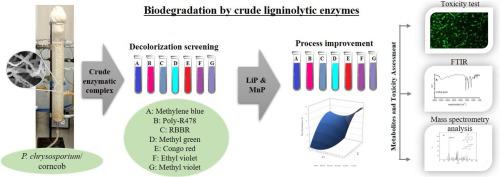Journal of Hazardous Materials ( IF 12.2 ) Pub Date : 2020-06-20 , DOI: 10.1016/j.jhazmat.2020.123254 Jazel Doménica Sosa-Martínez 1 , Nagamani Balagurusamy 2 , Julio Montañez 1 , Rosely Aparecida Peralta 3 , Regina de Fátima Peralta Muniz Moreira 4 , Adelar Bracht 5 , Rosane Marina Peralta 5 , Lourdes Morales-Oyervides 1

|
This work aimed to provide information that contributes to establishing environmental-friendly methods for synthetic dyes’ degradation. The potential decolorization capacity of the crude enzymatic extract produced by Phanerochaete chrysosporium CDBB 686 using corncob as a substrate was evaluated on seven different dyes. Critical variables affecting the in-vitro decolorization process were further evaluated and results were compared with an in-vivo decolorization system. Decolorization with enzymatic extracts presented advantages over the in-vivo system (higher or similar decolorization within a shorter period). Under improved in-vitro process conditions, the dyes with higher decolorization were: Congo red (41.84 %), Poly R-478 (56.86 %), Methyl green (69.79 %). Attempts were made to confirm the transformation of the dyes after the in-vitro process as well as to establish a molecular basis for interpreting changes in toxicity along with the degradation process. In-vitro degradation products of Methyl green presented a toxicity reduction compared with the original dye; however, increased toxicity was found for Congo red degradation products when compared with the original dyes. Thus, for future applications, it is crucial to evaluate the mechanisms of biodegradation of each target synthetic dye as well as the toxicity of the products obtained after enzymatic oxidation.
中文翻译:

真菌木质素分解酶对合成染料的生物降解:工艺优化,代谢物评估和毒性评估。
这项工作旨在提供有助于建立环境友好的合成染料降解方法的信息。使用玉米芯作为底物,对Phanerochaete chrysosporium CDBB 686生产的粗酶提取物的潜在脱色能力在七种不同的染料上进行了评估。进一步评估了影响体外脱色过程的关键变量,并将结果与体内脱色系统进行了比较。酶提取物的脱色表现出优于体内系统的优势(在较短时间内可实现更高或相似的脱色)。体外改良中在工艺条件下,具有较高脱色率的染料为:刚果红(41.84%),聚R-478(56.86%),甲基绿(69.79%)。试图确认染料在体外过程后的转化,并为解释毒性和降解过程的变化建立分子基础。与原始染料相比,甲基绿的体外降解产物降低了毒性。但是,与原始染料相比,刚果红降解产物的毒性增加。因此,对于将来的应用,至关重要的是评估每种目标合成染料的生物降解机理以及酶氧化后所得产物的毒性。











































 京公网安备 11010802027423号
京公网安备 11010802027423号